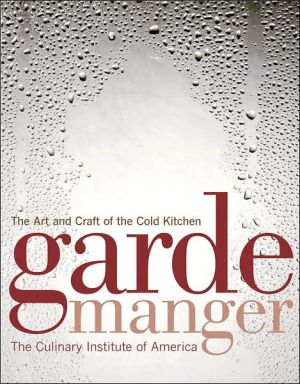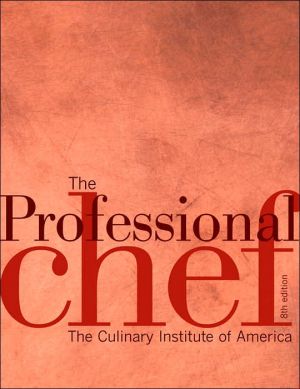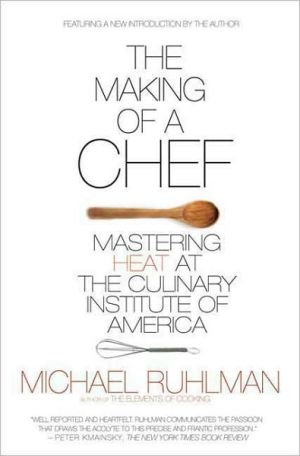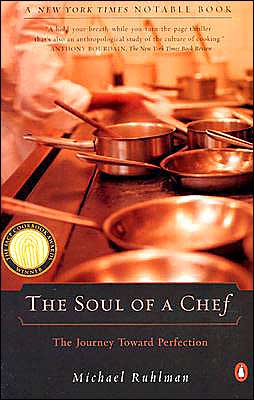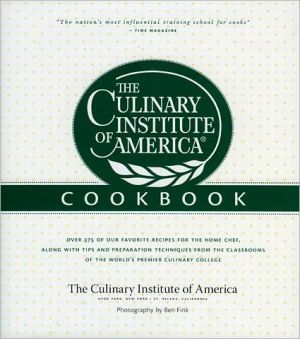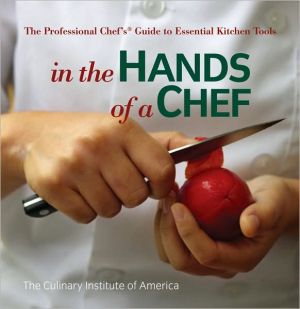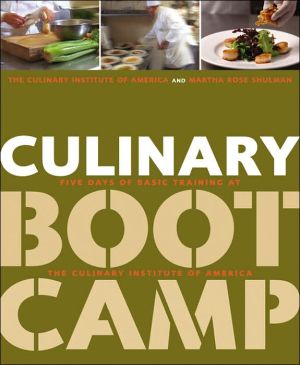Garde Manger: The Art and Craft of the Cold Kitchen
The leading guide to the professional kitchen's cold food station, now fully revised and updated\ Garde Manger is one of the most important courses culinary students take—and it's often the first kitchen station that a new chef will encounter. This definitive guide has been thoroughly revised to reflect the latest garde manger trends, techniques, and flavors, including new information on topics such as brining ratios, fermented sausages, micro greens, artisanal American cheeses, tapas menus,...
Search in google:
The leading guide to the professional kitchen's cold food station, now fully revised and updatedGarde Manger is one of the most important courses culinary students take—and it's often the first kitchen station that a new chef will encounter. This definitive guide has been thoroughly revised to reflect the latest garde manger trends, techniques, and flavors, including new information on topics such as brining ratios, fermented sausages, micro greens, artisanal American cheeses, tapas menus, "action" buffet stations, and ice carving. With over 540 recipes, including 100 created new for this edition, and more than 340 all-new photographs illustrating step-by-step techniques and finished dishes, this new edition of Garde Manger is an indispensable reference for culinary students and working chefs everywhere.
Garde Manger\ The Art and Craft of the Cold Kitchen \ \ By Culinary Institute of America \ Wiley Publishing\ Copyright © 2004 Culinary Institute of America\ All right reserved. \ ISBN: 0764576631 \ \ \ Chapter One\ The European Garde Manger Tradition \ As our ancestors became herdsmen and farmers, they developed the practical skills necessary to ensure a relatively steady food supply. This meant learning not only to domesticate animals and raise crops but also to preserve those foods. Fish were brined in seawater and left to dry on the shore, where they either fermented or dried. Meats were hung off the ground and near the fire. This kept them out of the reach of scavenging animals and insects. The smoky bath surrounding them darkened, flavored, dried, and preserved the meats and kept them from spoiling.\ Records of various curing methods have been tracked back as far as 3000 B.C.E., when it is believed the Sumerians salted meats as a way to preserve this valuable but perishable food. Historical evidence shows that the Chinese and the Greeks had been producing and consuming salted fish for many years before passing their knowledge on to the Romans. In 63 B.C.E., the Greek writer Strabo detailed the importance of fish-salting centers in Spain and the existence of salt producers in the Crimea. Salt cod, made in the same basic way Strabo described, is still an important food in cuisines around the world.\ Food-preservation skills and the necessary ingredients, including salt, sugar, and spices, were greatly valued. Cities such as modern-day Rome and Salzburg were founded near a ready source of salt. As the Romans extended their empire, they conquered lands rich in a variety of resources, including foodstuffs. They brought with them to new territory their own recipes and formulas for a variety of preserved meats, fish, cheeses, wines, and cordials. But the culinary exchange was never in one direction. The conquering forces also learned to appreciate the local specialties. The Gauls, in what became France, were credited as highly successful hog domesticators and became renowned for their preserved hams and bacon. These products were regularly sent from Gaul to Rome and served at the Romans' legendary banquets. After the fall of the Roman Empire, the great houses of the Church and the nobility throughout Europe kept alive both local food traditions and those learned from the invaders.\ Into the twelfth century, approximately 80 to 90 percent of the world's population still fell into a category known as rural peasants. These peasants worked the nobles' lands to raise crops and farm animals. One of the most important activities of the year occurred at the end of the growing season. Vegetables, fruits, and grains were harvested and preserved by drying or placing into cold storage, along with pickles, jellies, and cheeses. Cows, sheep, and other animals were butchered and the meat preserved by a variety of means: pickling, salting, brining, curing, drying, packing in fat, or smoking. Once the foods had been prepared, they could be held in storage.\ The right to collect and keep these foods, as well as to trade and tax them, was a visible symbol of power, wealth, and rank. During the Middle Ages, this privilege belonged to the kings, lords, dukes, and other nobility, as well as the monasteries and convents of the Catholic church. The castles and manor houses of the nobility each had an area devoted to food storage. This was typically located in an area below ground level to keep the foods cool. Garde manger (literally, "keeping to eat") was the term used to identify this storage area. It is still used to indicate a larder or pantry-a place for cold food storage. The member of the household staff known as the officier de bouche, or steward, was responsible for managing this storeroom, dispensing foods as necessary.\ The Growth of the Guilds\ Some of these special stored items, such as hams and cheeses, became part of the commerce and trade between towns and states. They were included as dowries and tributes, along with livestock, buildings, servants, and jewels, and served as a kind of currency to acquire other goods. Eventually, rules were established governing how merchants prepared and sold these goods and services, the goal being to prevent monopolies and pricing abuses. The work itself was clearly defined and assigned to various groups known as guilds. The guilds developed training systems for their members, taking them from an apprenticeship to the journeyman stage and, finally, conferring the status of master. Each individual guild was granted a charter that gave its members specific rights.\ By the end of the sixteenth century, approximately two dozen guilds were dedicated specifically to food. These fell into two groups-those that provided raw materials and those that provided prepared foods. The guild that prepared and sold cooked items made from the pig was referred to as charcuterie, derived from French root words meaning "cooked flesh." This guild kept the practical work of preserving meats alive and thriving, making bacons, hams, sausages, and pbtis.\ Numerous strategies were devised to get around restrictions imposed on any given guild, and the charcutihres (members of the charcuterie guild) were no exception. One of their tactics led to the development of terrines: Charcutihres were not permitted to sell foods baked in pastries. Making and selling forcemeat loaves baked in pastry-pbti en cro{te-would not have been allowed, according to a strict reading of the charcutihre's charter. Rather than stop making pbti en cro{te, the charcutihres baked the forcemeat in an earthenware mold instead of pastry-and so pbtis en terrine were created.\ Restaurants and the Role of the Garde Manger\ The more essential the food, the more closely it was regulated. The more lucrative a guild's activities, the more likely it was that another guild might be tempted to infringe on it. Each guild fought to protect its individual rights. Several cases were brought before judges to determine if one guild's activities had crossed the line into the work of another's.\ One such case had a profound impact on the work of today's garde manger. In 1765, Monsieur Boulanger, a tavernkeeper, was brought to court for selling a hot dish, which he referred to as a restorante ("restorative"). Traditionally, the right to sell hot prepared foods such as this restorative had been the exclusive privilege of another guild. The judge ruled that M. Boulanger had not broken any law, and so the first restaurant was born. Others quickly followed this new type of venture.\ When the French Revolution began in 1789, the upheavals in noble households were enormous. Noblemen left France to escape the guillotine, leaving their household staffs to care for themselves. The garde manger (or steward), as well as chefs and cooks, were household employees and as such did not have a formal guild of their own. These workers found their way into restaurants in increasing numbers throughout Europe and the British Isles.\ At first, there was no widely recognized structure for kitchen workers. There were no established duties or areas of specialization. It took several years before a serious attempt was made to organize the kitchen workers. Eventually, the brigade system, as recorded by Auguste Escoffier, detailed a logical chain of command that brought order to the unruly working arrangements of his day. We still use the brigade system and refer to the various stations in the kitchen with the names assigned by Escoffier: saucier, rttisseur, pbtissier, and garde manger.\ When the guild system was abolished in 1791, some members of the charcutihres' guild also joined the ranks of restaurant and hotel kitchen garde manger staffs. Others continued to operate their businesses as before. The work of the charcutihre and that of the garde manger have always been closely linked, since both are founded on cold preserved foods. When the term garde manger is used today, it is often understood to include the work of the charcutihre as well.\ Today's Garde Manger\ The garde manger, recast in a restaurant setting, has retained its tradition of preparing a variety of preserved and cold foods. It has also expanded its scope to include hors d'ouevre, appetizers, salads, sandwiches, and the accompanying cold sauces and condiments. Garde manger is involved in ' la carte service as well as receptions, buffets, and banquets.\ The techniques required to prepare pbtis, terrines, sausages, and fresh cheeses are the particular domain of the garde manger. To support the techniques and production in the cold kitchen, a wide variety of hot food-preparation techniques that are essential to the foundation of any culinary discipline must be mastered: roasting, poaching, simmering, and sautiing meats, fish, poultry, vegetables, grains, and legumes.\ It is precisely because the skills and responsibilities are so broad that many of today's most highly regarded chefs began their careers in the garde manger department as an apprentice or commis. In addition, recent years have seen a rebirth of the more traditional practices of charcuterie and cheese making by purveyors with retail shops and wholesale businesses. Handcrafted foods such as country-style hams, sausages, pbtis, and fresh and aged cheeses are increasingly available to both the restaurant chef and the home cook.\ Establishments\ Hotels, full-service restaurants, and private clubs may have one or more people working exclusively in the area of garde manger, though its specific name varies from place to place. Some operations refer to it as the pantry, others may call it the salad station, still others the cold side, and so on. The specific foods for which this station is responsible can include cold sauces and soups, salads, hors d'oeuvre, and canapis.\ This station may, in some kitchens, supply other stations with particular items. The garde manger, in some operations, also shapes and portions meats, poultry, and fish, adding marinades or stuffings as appropriate.\ During service, the garde manger typically plates salads and cold appetizers and may also be responsible for plating desserts. The breakfast, lunch, and brunch menus often rely heavily on the garde manger as well.\ Cooks and chefs working in banquet and catering operations practice all the same basic cooking skills as the garde manger in an ' la carte restaurant. The approach to work is slightly different. This work is so stimulating and challenging that many professionals choose it as their lifelong career path. Here, where the goal is to produce and serve flavorful, attractive food to large numbers of individuals simultaneously, you learn to use the special equipment and cooking techniques of volume production. The chef not only develops a menu but also does all the planning necessary to come up with scaled recipes, accurate and timely orders for food and other items, and food costs. Presentation is often a significant component of banquets and receptions. Dicor, appropriate and effective garnishes for plates, platters, and other food displays, and concerns for food quality and customer safety are considered. The nature of large events often involves a certain level of risk and always calls for the ability to think under pressure and come up with a creative solution to a crisis. To read more about the development and management of a buffet, read Chapter 11.\ Delicatessens, charcuteries, and shops selling prepared foods of all types offer yet more options for the professional garde manger. Some operations feature handcrafted foods such as cheeses and sausages. Their goods may be sold through a retail shop or exclusively to those in the restaurant trade. Large companies, including hotel and restaurant chains and food manufacturers, look to those with strong skills in garde manger to undertake projects such as the development of a new line of sauces or condiments, spice rubs, or salad blends.\ Types of work\ Both employers and schools recognize that formal education on its own is not enough to assure excellence. Garde manger is a practical art. To succeed, you must work hard to develop precise skills. Whether you work for yourself or for someone else, you must make choices about your work carefully. It is tempting to make a decision based on salary, location, or similar immediately tangible reward. However, if you consider each job as an investment in your future, it is far easier to evaluate its long-lasting rewards.\ Making wise career choices is complicated, so take the time to evaluate any career move. Develop your own plan for the future as specifically as you can so you can determine the type of establishment and the type of work that will set you up to secure the next level in your career.\ Look for work environments where every person has a stake in getting things done correctly. When every person has the opportunity to help make decisions and has the tools he or she needs to perform well, everyone succeeds. If you want to do a job well, you need to know the quality standards. Objective evaluations, constructive criticism, and additional training are part of every good working situation.\ Entry level\ Work at the entry level includes cleaning and cutting produce, making vinaigrettes and composed platters, and following simple standard recipes under supervision. It is important to ask questions and follow advice, watch carefully what goes on around you, and supplement what you see and hear by reading. Learn the skills necessary for handling special equipment safely and efficiently. Slicers, mixers, grinders, blenders, food processors, thermometers, smokers, sausage stuffers, and salometers are just a few of the specialized pieces of equipment used in the garde manger and smokehouse.\ Advanced level\ As your skills improve, you move from entry-level positions into positions of more responsibility. You take on more advanced and challenging work, and you may advance to lead or executive chef. At this level, you have more responsibility for conceiving new menu items, including recipe development, recording standard recipes, and costing and developing and maintaining a budget. You train kitchen and dining room staff in the proper presentation of the new and standard menu items.\ Banquet and buffet chefs develop menus-both standard and custom-and go through the process of scaling and costing each menu item. Staffing and scheduling responsibilities for the banquet chef include maintaining and training a relatively large pool of talent, often in conjunction with the dining room manager. Some special aspects of this work include coordinating with other service providers such as florists, musicians, and photographers.\ Entrepreneurs develop handcrafted specialty items that are produced on both small and large scale. Their work focuses more on the development of a product or product line that is for sale in the retail or wholesale market.\ Continues...\ \ \ \ Excerpted from Garde Manger by Culinary Institute of America Copyright © 2004 by Culinary Institute of America. Excerpted by permission.\ All rights reserved. No part of this excerpt may be reproduced or reprinted without permission in writing from the publisher.\ Excerpts are provided by Dial-A-Book Inc. solely for the personal use of visitors to this web site. \ \
Prefaceviii1The Professional Garde Manger12Cold Sauces and Cold Soups153Salads754Sandwiches1375Cured and Smoked Foods1796Sausage2277Terrines, Pates, Galantines, and Roulades2718Cheese3339Appetizers and Hors d'Oeuvre36110Condiments, Crackers, and Pickles46711The Modern Buffet49512Basic Recipes521Glossary551Bibliography and Recommended Reading561Recipe Index564Subject Index579
